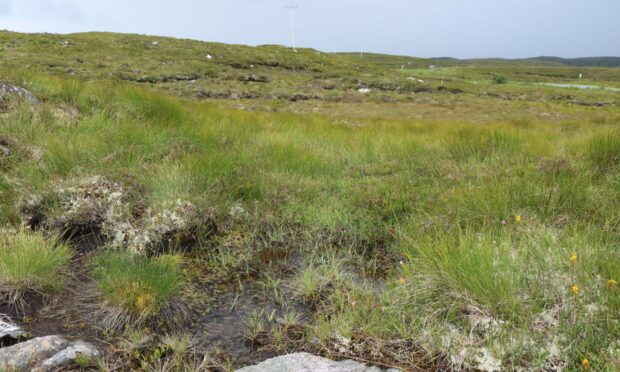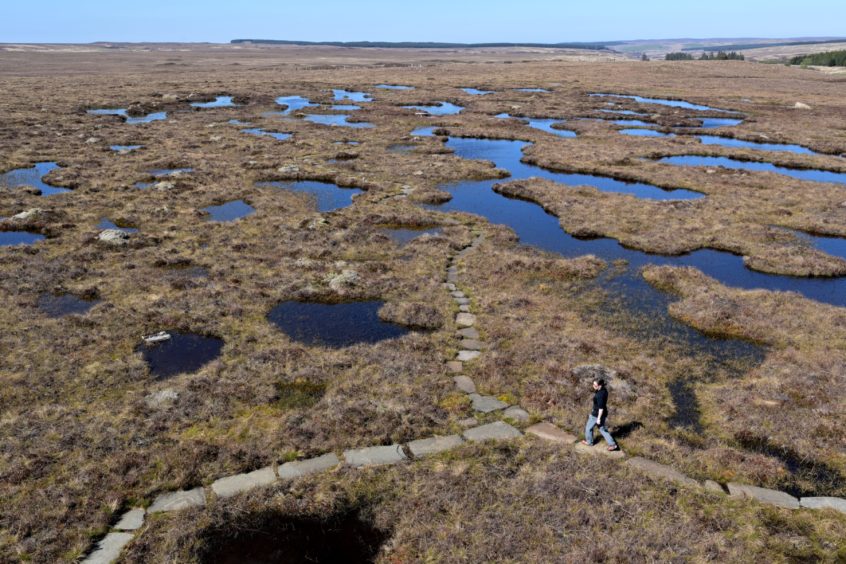Scottish Water is working with community groups on Lewis to restore eroding and damaged peatlands.
Areas of peatland are important because they act as vital carbon storage, promote biodiversity and protect drinking water sources.
Loch Fasgro and Loch Orasaigh are areas of peatland on Lewis which are currently being restored.
Scottish Water is working on the restoration with NatureScot’s peatland action team as well as grazing and estate groups from the local community.
The project at Loch Orasaigh is already moving into its third phase, with plans to restore a further 20 hectares, taking the total area of restored land to more than 60 hectares.
The project at Loch Fasgro is newer, though four hectares have already been worked on.
‘Largest natural carbon store in the world’
The aim of the restoration projects is to return areas of blanket bog to more natural conditions.
This stops erosion of the peat and regulates the flow of water, encouraging peat-forming vegetation to thrive.
Malcolm Walker, Scottish Water’s catchment liaison officer, explained the benefits of the work.
He said: “Peatlands are the largest natural carbon store in the world and play a vital role in tackling climate change – projects such as these which focus on restoring and protecting these areas are of increasing importance as we all focus on the drive towards net zero emissions.
“When the peatland is exposed to the elements, it will dry out and erode.
“As well as releasing carbon into the environment, it also means the peat gets washed into our drinking water reservoirs and we then have to remove it during the treatment process at the water treatment works which can be costly and time consuming.”
A tradition spanning generations
The team at Scottish Water worked with community groups to ensure they were happy with the work being done on the peatlands.
On the island, there is a long-standing tradition of peat cutting for domestic fuel, so it was important that this was respected.
Alan Iain MacLeod is part of the Ranish Grazings Committee.
He explained the tradition of peat cutting: “Peat cutting has been a part of our life for my lifetime, and the generations before me as well.
“You went out to do it with your neighbour and your neighbour came out with you and regardless of how many in the household, everybody in the household was involved.
“When we cut the peat, you’re left with this bare land part of it and if you have running water running off it, the silt will then make its way through the water course naturally into the reservoirs.”
Mr MacLeod saw the positive side of Scottish Water’s proposal to restore the peatland.
He said: “Scottish Water explained to us exactly what they were wanting to do and how they were trying to do it, and we decided that we would like to take the opportunity to move forward with them to try and improve source water quality – if it reduces the amount of dirty run off, it costs them less to produce the water that we drink.”
330 hectares worth of restoration
The Scottish Government has set targets for peatland restoration in an attempt to reduce the amount of carbon dioxide they can release into the atmosphere.
When peat dries and cracks, the carbon it has been storing since its formation is released into the atmosphere as greenhouse gases.
Restoration prevents this from happening as raises the water table and enables growth of new peat.
Ben Inglis-Grant, peatland action project officer, explained: “By reversing and limiting erosion and enabling the peatland to recover to its natural state, at both Loch Fasgro and Loch Orasaigh, we are not only restoring the local peatland habitat and improving nearby water quality but we are also playing our part in helping to meet the Scottish Government targets for peatland restoration in Scotland.”
Throughout 2021 and 2022, Scottish Water aims to deliver around 330 hectares worth of peatland restoration across Scotland.
This should help in the fight against climate change by storing the equivalent of 231 to 924 tonnes of carbon dioxide per year.

